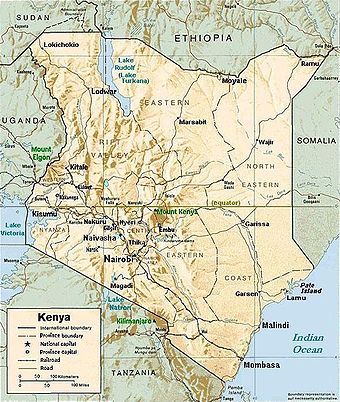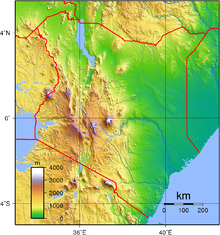- Geography of Kenya
-
The geography of Kenya is diverse. Kenya has a coastline on the Indian Ocean, which contains swamps of East African mangroves. Inland are broad plains and numerous hills. Central and Western Kenya is characterized by the Great Rift Valley home to three of Africa's highest mountains, Mount Kenya, Mount Elgon and Kilimanjaro. The Kakamega Forest in western Kenya is relic of an East African rainforest. Much larger is Mau Forest, the largest forest complex in East Africa.
Contents
Geography
Location
- Eastern Africa, which is between Somalia and Tanzania
- Geographic coordinates: 1°00′N 38°00′E / 1°N 38°E
Area
- Total: 580,367 km2 (224,081 sq mi)
- Land: 569,140 km2 (219,750 sq mi)
- Water: 11,227 km2 (4,335 sq mi)
Land boundaries
- Total: 3,477 km (2,161 mi)
- Border countries: Ethiopia 861 km (535 mi), Somalia 682 km (424 mi), South Sudan 232 km (144 mi), Tanzania 769 km (478 mi), Uganda 933 km (580 mi)[1]
Coastline
- 536 km along the Indian Ocean.
Maritime claims
- Continental shelf: 200 m depth or to the depth of exploitation
- Exclusive economic zone: 200 nmi (370.4 km; 230.2 mi)
- Territorial sea: 12 nmi (22.2 km; 13.8 mi)
Climate
The climate of Kenya varies by location, from mostly cool every day, to always warm/hot.[2][3][4] The climate along the coast is tropical. This means rainfall and temperatures are higher throughout the year. At the coastal city Mombasa, the air changes from cool to hot, almost every day (see chart below).[4] The further inside Kenya, the more arid the climate becomes. An arid climate is nearly devoid of rainfall, and temperature swings widely according to the general time of the day/night. For many areas of Kenya, the daytime temperature rises about 12 °C (53.6 °F), almost every day. [2][3][4]
Elevation is the major factor in temperature levels, with the higher areas, on average, as 11°C (20°F) cooler, day or night.[2][3][4] The many mile-high cities have temperature swings from roughly 50–79 °F (10–26.1 °C). Nairobi, at 1,798 m (5,899 ft) or 1.798 km (1.12 mi), ranges from 49–80 °F (9.4–26.7 °C),[2] and Kitale, at 1,825 m (5,988 ft) or 1.825 km (1.13 mi), ranges from 51–82 °F (10.6–27.8 °C).[3] The overnight lows are not like the "Garden of Eden" because, at night, heavy clothes or blankets are needed, in the highlands, when the temperature drops to about 50–54 °F (10–12.2 °C) every night.At lower altitudes, the increased temperature is like day and night, literally: like starting the morning at the highland daytime high, and then adding the heat of the day, again. Hence, the overnight low temperatures near sealevel are nearly the same as the high temperatures of the elevated Kenyan highlands. However, locations along the Indian Ocean have more moderate temperatures, as a few degrees cooler in the daytime, such as at Mombasa (see chart below).
There are slight seasonal variations in temperature, of 4 °C or 7.20 °F,[2][3][4] cooler in the winter months. Although Kenya is centered at the equator, it shares the seasons of the southern hemisphere: with the warmest summer months in February-March and the coolest winter months in July-August, although only a few degrees cooler. [2][3][4]
On the high mountains, such as Mount Kenya, Mount Elgon and Kilimanjaro, the weather can become bitterly cold for most of the year. Some snowfall has occurred on the highest mountains.
Climate Data for Mombasa (at Indian Ocean)[4] NOAA Code Statistic Jan Feb Mar Apr May Jun Jul Aug Sep Oct Nov Dec Avg 0101 Temperature
Average F81.7 82.6 82.9 81.7 79.2 76.6 75.2 75.2 76.5 78.3 80.4 81.3 79.3 0201 Temperature
High value F91.8 92.7 92.7 90.5 87.6 84.9 83.7 83.8 85.5 86.9 88.9 91 88.3 0301 Temperature
Low value F71.6 72.5 73.2 72.9 70.9 68.2 66.7 66.7 67.5 69.6 71.8 71.6 70.3 0615 Precipitation
in inches[4]1.4 0.6 2.3 6.3 9.7 3.6 2.9 2.8 2.8 4.2 4.3 3.1 3.7 0101 Temperature
Average C27.6 28.1 28.3 27.6 26.2 24.8 24.0 24.0 24.7 25.7 26.9 27.4 26.27 0201 Temperature
High value C33.2 33.7 33.7 32.5 30.9 29.4 28.7 28.8 29.7 30.5 31.6 32.8 31.29 0301 Temperature
Low value C22.0 22.5 22.9 22.7 21.6 20.1 19.3 19.3 19.7 20.9 22.1 22.0 21.26 0615 Precipitation
in mm[4]33.9 14.0 55.6 154.3 246 88.3 71.8 68.2 67.2 103.4 104.7 75.8 89.39 1109 Humidity
Maximum %76.0 76.0 78.0 82.0 85.0 84.0 86.0 85.0 82.0 81.0 80.0 78.0 81.08 1110 Humidity[4]
Minimum %62.0 59.0 61.0 66.0 70.0 67.0 67.0 66.0 65.0 66.0 68.0 65.0 65.17 Terrain
Kenya’s terrain is composed of low plains that rise into central highlands that are, in turn, bisected by the Great Rift Valley.
Elevation extremes
The lowest point on Kenya is at sea level on the Indian Ocean. The highest point on Kenya is 5,199 meters above sea level at Mount Kenya.
Rivers
The two main rivers are the Galana and the Tana. However, the Ewaso Ng'iro is a very important river supplying water from Mt. Kenya to the northern part of Kenya.
Natural resources
Natural resources that are found on Kenya include limestone, soda ash, salt, gemstones, fluorspar, zinc, diatomite, gypsum, wildlife and hydropower.
Land use
8.01% of the land is arable. Permanent crops occupy 0.97% of the land. Other uses make up the rest of Kenya's land. (2005)
Irrigated land
1030 km² of Kenya' land is irrigated.(2010)
Natural hazards
Natural hazards include recurring drought and flooding during the rainy seasons.
The Environmental issues
Current issues
Current issues that threaten the environment at the moment include water pollution from urban and industrial wastes; degradation of water quality from the increased use of pesticides and fertilizers; deforestation; soil erosion; desertification and poaching.
International agreements
- Party to: Biodiversity, Climate Change, Desertification, Endangered Species, Law of the Sea, Marine Dumping, Marine Life Conservation, Nuclear Test Ban, Ozone Layer Protection, Ship Pollution (MARPOL 73/78), Wetlands, Whaling
- Signed, but not ratified: none of the selected agreements
Extreme points
This is a list of the extreme points of Kenya, the points that are farther north, south, east or west than any other location.
- Northernmost point - Kalukwakerith mountain, Rift Valley Province*
- Eastern-most point - the tripoint with Ethiopia and Somalia, North Eastern Province
- Southern-most point - the point where the border with Tanzania enters the Indian Ocean, Coast Province
- Western-most point - unnamed headland immediately east of Port Victoria, Nyanza Province
- Note: This is including the disputed Ilemi Triangle region. If this area is excluded then Kenya does not have a northern-most point, the northern border being a straight line
See also
References
- ^ cia.gov – The World Factbook Kenya
- ^ a b c d e f "NairobiDagoretti, Kenya: Climate, Global Warming, and Daylight Charts and Data", Climate-Charts.com, 2008, web: CC741: compare Nairobi/Dagoretti data with the Kitale or Mombasa charts.
- ^ a b c d e f "Kitale, Kenya: Climate, Global Warming, and Daylight Charts and Data", Climate-Charts.com, 2008, web: CC661.
- ^ a b c d e f g h i j "Mombasa, Kenya: Climate, Global Warming, and Daylight Charts and Data", Climate-Charts.com, 2008, web: CC820: May precipitation was reset as "246" mm, converting 9.7 in.
Sovereign
states- Algeria
- Angola
- Benin
- Botswana
- Burkina Faso
- Burundi
- Cameroon
- Cape Verde
- Central African Republic
- Chad
- Comoros
- Democratic Republic of the Congo
- Republic of the Congo
- Côte d'Ivoire (Ivory Coast)
- Djibouti
- Egypt
- Equatorial Guinea
- Eritrea
- Ethiopia
- Gabon
- The Gambia
- Ghana
- Guinea
- Guinea-Bissau
- Kenya
- Lesotho
- Liberia
- Libya
- Madagascar
- Malawi
- Mali
- Mauritania
- Mauritius
- Morocco
- Mozambique
- Namibia
- Niger
- Nigeria
- Rwanda
- São Tomé and Príncipe
- Senegal
- Seychelles
- Sierra Leone
- Somalia
- South Africa
- South Sudan
- Sudan
- Swaziland
- Tanzania
- Togo
- Tunisia
- Uganda
- Zambia
- Zimbabwe
States with limited
recognition- Sahrawi Arab Democratic Republic
- Somaliland
Dependencies and
other territories- Canary Islands / Ceuta / Melilla / Plazas de soberanía (Spain)
- Madeira (Portugal)
- Mayotte / Réunion (France)
- Saint Helena / Ascension Island / Tristan da Cunha (United Kingdom)
- Western Sahara
Climate of Africa Sovereign
states- Algeria
- Angola
- Benin
- Botswana
- Burkina Faso
- Burundi
- Cameroon
- Cape Verde
- Central African Republic
- Chad
- Comoros
- Democratic Republic of the Congo
- Republic of the Congo
- Côte d'Ivoire (Ivory Coast)
- Djibouti
- Egypt
- Equatorial Guinea
- Eritrea
- Ethiopia
- Gabon
- The Gambia
- Ghana
- Guinea
- Guinea-Bissau
- Kenya
- Lesotho
- Liberia
- Libya
- Madagascar
- Malawi
- Mali
- Mauritania
- Mauritius
- Morocco
- Mozambique
- Namibia
- Niger
- Nigeria
- Rwanda
- São Tomé and Príncipe
- Senegal
- Seychelles
- Sierra Leone
- Somalia
- South Africa
- South Sudan
- Sudan
- Swaziland
- Tanzania
- Togo
- Tunisia
- Uganda
- Zambia
- Zimbabwe
States with limited
recognition- Sahrawi Arab Democratic Republic
- Somaliland
Dependencies and
other territories- Canary Islands / Ceuta / Melilla / Plazas de soberanía (Spain)
- Madeira (Portugal)
- Mayotte / Réunion (France)
- Saint Helena / Ascension Island / Tristan da Cunha (United Kingdom)
- Western Sahara
Categories:
Wikimedia Foundation. 2010.



